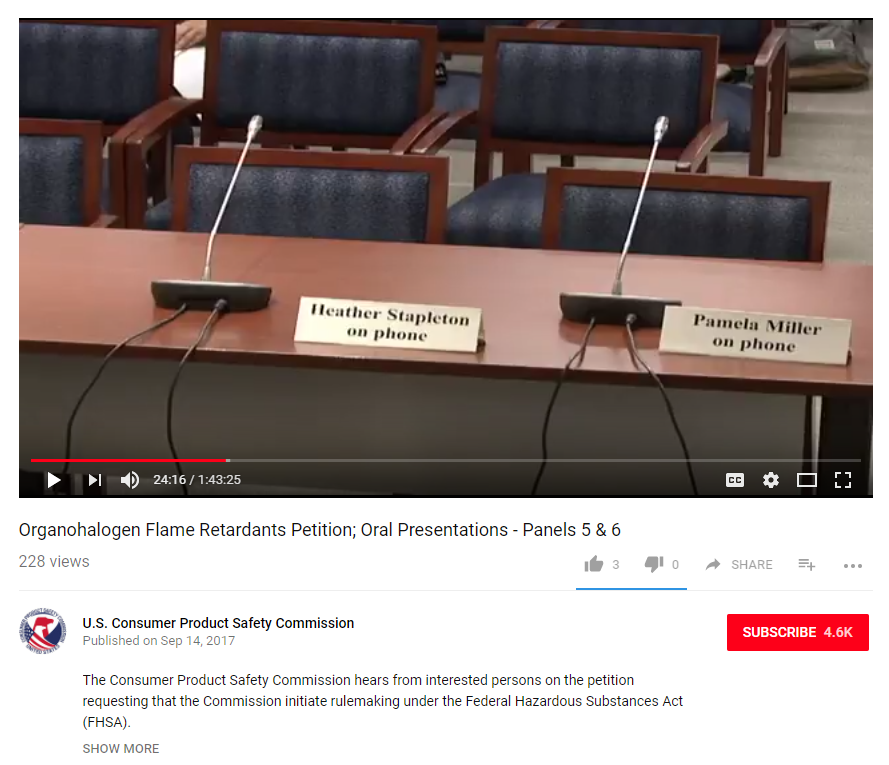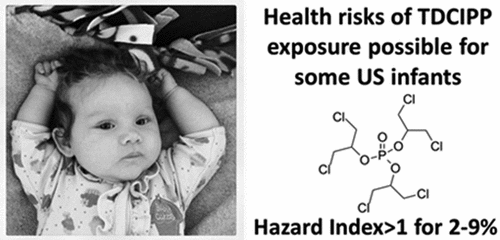
Dr. Heather Stapleton, Duke Superfund Research Center Co-Director and PI of Project 2, recently testified in front of the U.S. Consumer Product Safety Commission (CPSC) at a hearing for a petition to ban organohalogen flame retardants in consumer products under the Federal Hazardous Substance Act. Dr. Stapleton’s research focuses on identifying additive chemicals (particularly flame retardants such as polybrominated diphenyl ethers, or PBDEs) in consumer products and evaluating both how people are exposed to them and the potential health impacts of those exposures. On September 14, she testified on a panel that discussed the existing research and various organizational stances concerning the use and health impacts of organohalogen flame retardants. This petition was developed by a coalition of public health researchers and advocates including: the American Academy of Pediatrics, American Medical Women’s Association, Consumer Federation of America, Consumers Union, Green Science Policy Institute, International Association of Fire Fighters, Kids in Danger, Philip J. Landrigan, M.D., M.P.H., League of United Latin American Citizens, Learning Disabilities Association of America, National Hispanic Medical Association, and Worksafe. The petition to the CPSC was brought by Earth Justice and can be read in its entirety here.

Dr. Stapleton has extensive experience with flame retardants in consumer products and is known as one of the foremost experts in the field. She previously testified in front of the U.S. Senate Subcommittee on the Environment and Public Works hearing on Environmental Protection Agency oversight of flame retardants and other toxic chemicals under the Toxic Substances Control Act (TSCA) in May, 2012. Her lab has been specifically testing flame retardant chemicals found in sofas, mattresses, chairs, and a variety of baby items for 9 years. In her address, she stated that foam samples from over 2,000 products have been tested by her research group through the Duke University Foam Project (https://foam.pratt.duke.edu/), lending valuable insight into how exposure among the general public might relate to product use.
Stapleton went on to say that despite changes in the California flammability standard that decreased the required amount of flame retardants in foam, mattresses sold today (especially memory foam) contain organohalogen flame retardants and the use is not decreasing. In citing a recent publication by Hoffman et al. (ES&T Letters, 2017), she stated that “exposure to the halogenated organophosphate flame retardant (TDCCP, also known as chlorinated tris) has increased significantly in the U.S. population in the last decade…and that exposure to this chemical, which is considered a carcinogen…is significantly greater in young children relative to adults.” It is important to note that Stapleton’s research shows “TDCCP is the most common flame retardant applied to baby furniture items that contain polyurethane foam.” The fact that infants have higher exposure compared to all other age groups is of concern because they are at a vulnerable stage in their development and could be impacted by long-term negative effects from exposure including attention barriers and behavioral issues. You can access Dr. Stapleton’s full testimony at this link.

Stapleton’s testimony was supported by her 17 years of research on this specific issue, represented by over 70 peer reviewed publications. Other individuals on the panel included: Katie Huffling from the Alliance of Nurses for Healthy Environments, Jenna Reed from the Union of Concerned Scientists, Robert Simon/Mike Walls from the American Chemistry Council, Sonia Lunder from the Environmental Working Group, and Pamela Miller from Alaska Community Action on Toxins. You can access a summary of their testimonies as well as input and opinions from commissioners present at the public hearing in this Chicago Tribune article. The majority of the panel expressed their concern with the continued use of organohalogen flame retardants in furniture and baby products. There were also several reflections on the 2012 Senate panel discussing flame retardants as well as a The public hearing ended with a statement of concern for children’s health, with commissioner Elliot Kaye stating, “If at the end of the day, we look back at this decision and determine we made a mistake, I would far rather make a decision that is too protective of children rather than one that falls far short of that.”
On September 28, 2017, the Consumer Product Safety Commission’s decision was published in the Federal Register. The Commission voted 3-2 to approve an official Guidance Document recommending “manufacturers of children’s products, upholstered furniture sold for use in residences, mattresses (and mattress pads), and plastic casings surrounding electronics refrain from intentionally adding non-polymeric, organohalogen flame retardants to their products.” The statement went on to include if “labeling is not adequate to protect against the potential hazard, the Commission may declare the product banned” as well as if a product intended for or available for access to children is found to contain hazardous substances, “the article is a banned hazardous substance.”
Related References:
Hammel, SC, Hoffman, K, Lorenzo, AM, Chen, A, Phillips, AL, Butt, CM, Sosa, JA, Webster, TF, and Stapleton, HM. “Associations between flame retardant applications in furniture foam, house dust levels, and residents’ serum levels. “ Environment international, 107 (October 2017): 181-189.
Hoffman, K, Gearhart-Serna, L, Lorber, M, Webster, TF, and Stapleton, HM. “Estimated Tris(1,3-dichloro-2-propyl) Phosphate Exposure Levels for U.S. Infants Suggest Potential Health Risks.” Environmental Science & Technology Letters 4, no. 8 (August 8, 2017): 334-338.
Hoffman, K, Webster, TF, Sjödin, A, and Stapleton, HM. “Toddler’s behavior and its impacts on exposure to polybrominated diphenyl ethers.” Journal of exposure science & environmental epidemiology 27, no. 2 (March 2017): 193-197





